The Flight Checklist
of Hot Air Balloons
Mathematics Involved...
(Return to Previous Page)
As can be seen from this checklist, there
are only a few mathematical influences on the launching and piloting
side of hot air ballooning. Basically, it comes down to the following:
how much weight will I take on the flight, how long can I fly
and when can I launch. Everything else, is basically safety/common
sense. Finding an appropriate area to land, may need a little
figuring, only in the sense of knowing if there is enough room
to disassemble the craft.
A typical checklist would contain the following
items:
1. Always - Before Flight Checklist
1. Balloon within Annual 100 Hour Inspection Period
Safety check included on this list as a reminder to not fly
if it hasn't been checked recently.
2. Weather Brief (WillbanksRule 93/SW8/WA15)
The rule is, if it isn't perfect conditions, then ask yourself..."When
I'm up there, would I rather be down here?". If the answer
is even remotely, yes, you don't launch. It is much better to
be on the ground, wanting to launch (and not launching) than
to be in the air and wanting to land.
If you are curious about your weather forecast, click on the
link below, enter your city and state in box labelled #1 and
enter 'travel' in box #2.
Click Here for Weather.com
3. Load Check - Never more than 700 lbs. of "Human
Flesh".
Weight Limits
Weight limits are unique for each balloon: The size of the
balloon and the inclusion of standard equipment (i.e. propane
tanks filled, basket, etc) will yield a "not to exceed"
weight that can be included.
That is the starting point. Since the lift is determined by
the buoyancy of the air, air temperature and pressure must be
factored into the equation. The time of day will also impact
the air temperature, external to the balloon as well as internal,
as the balloon can absorb heat from the sun. There is a limit
to the elevation of the sun above the horizon (30 degrees) that
balloonist adhere to where they will not be in the air after
that point of time. All ballooning is confined to the hours just
after sunrise and just before sunset.
This particular checklist was setup for a balloon that was
designed for about 1,200 lbs. Taking into account the fuel, basket
etc., the balloon is conservatively limited to 700 lbs. of personnel.
4. Launch Site - Check for obstacles downwind. Check for
Power Lines. Get Landowner OK's.
Safety check to determine how fast altitude must be gained
to clear obstacles. Special not is made for power lines, as these
are not as easily visible in the air.
5. Fuel Planning - Flight Time Rule: "Sun not more
than 30 degrees from the horizon"
The fuel tanks are used conservatively. Must plan to leave
at least 25% of the fuel taken on board. With 4 tanks, this means
1 tank should also be available, just in case...
The sun rule, normally means that launch and flying should
be within 2 hours of sunrise or sunset.
6. Wind Direction - Landing Area - Test helium balloon
(Piball)
Test belloons are used to determine the amount, direction
and altitude of the winds for that day. Note than when one is
flying, there are always the possibility of finding thermal areas
that will allow for changes in the direction of the wind at different
locations and altitudes.
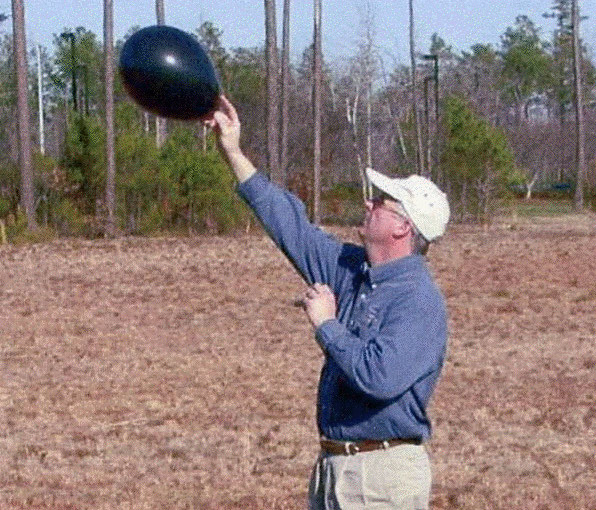
7. Envelope Placement Downwind
Initial ambient temperature air is blown into the balloon
to fill it out. An additional fan is used to accomplish this.
(takes about 10 minutes, depending on size of the balloon and
the fan) This cannot be accomplished unless the balloon is downwind.
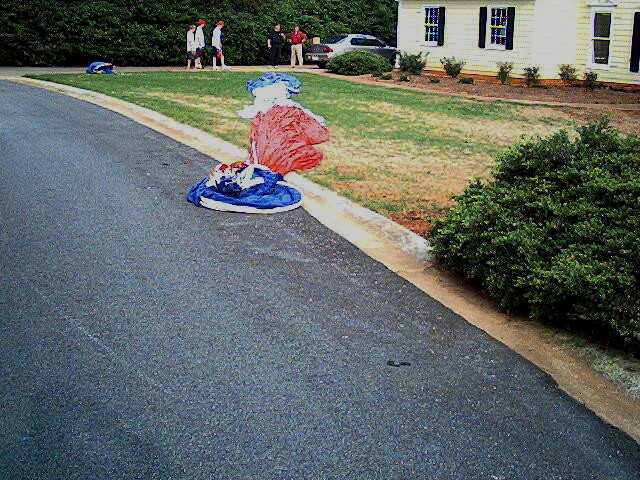
8. Necessary Documents Onboard - Flight Manual, Air Worthiness
Certificate, Registration and Pilot's License, Area Map, Sectional
Chart - Detail of Red Zones.
Basic navigation aids and legal requirements (license plate)
9. Functioning Communication Equipment (Radio, CB, FRS,
etc.)
You must have communication with the ground team in order
to plan for landing. Please note, that although cellular phones
can be used, since cellular is specifically a terrestial based
system it should not be used from any aircraft.
Up to this point, only the components have
been taken out of the trailer and the basket items checked. If
the weather or the site chosen to take off from are not acceptable,
the launch can be scrubbed. From discussions with balloonists,
usually only 1 in 10 tries will you be able to take off.
2. Layout and Inflation
1. Brief Crew and Assign tasks to each
Management....
2. Basket and Burner Assembly
Setup, ready for inflation of the envelope.
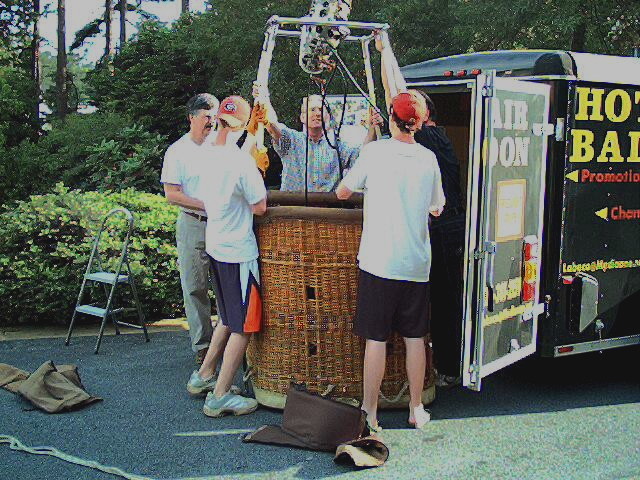
3. Secure anchor tie-off
Don't want to have the balloon drifting around on the ground,
before launch.
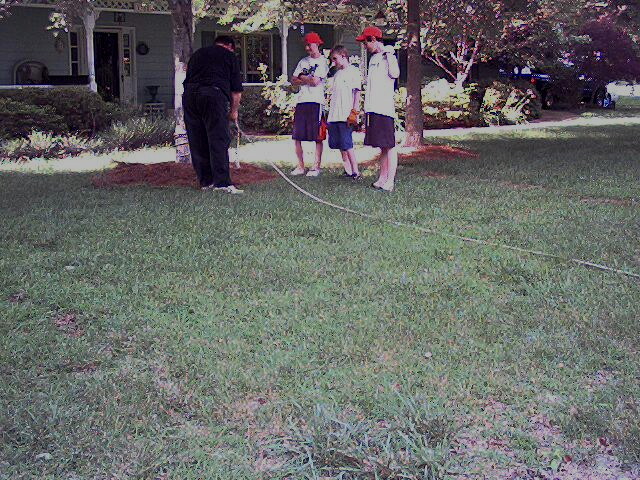
4. Basket Connection
- Color Coded Cables; "Head" nameplate alignment,
Vent velcro tabs, Pyrometer
connect, Loose vent line tie to basket, Inflator fan position,
Fan Stabilized
The basket gets attached at this point. Note the pyrometer
connection, to allow for determination of the temperature of
the flame/hot air. The fan is setup to allow cold inflation of
the balloon - i.e. prior to heating the air.

5. Cold Inflation - to "tight and fat" the envelope
Using the fan, inflate until the envelope, still on the ground,
is as tight as possible.

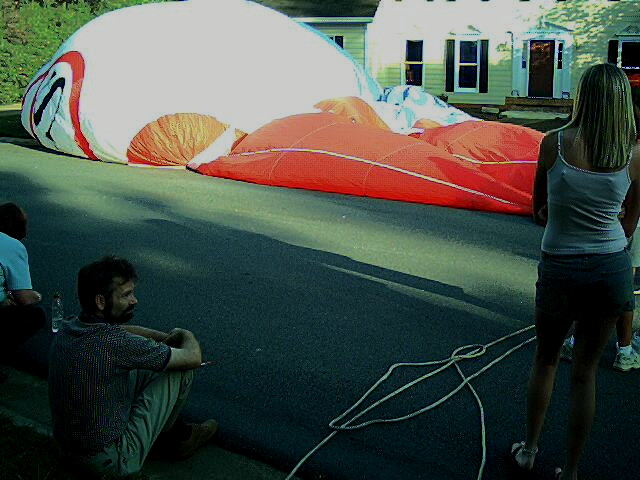
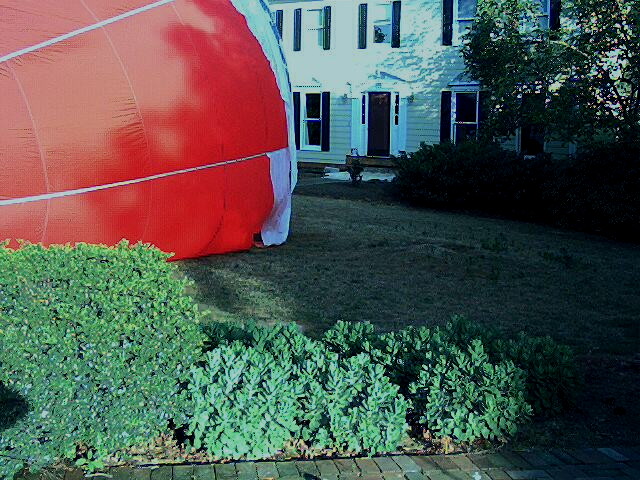
6. Envelope Inspection for Integrity
Safety check...
7. "Thumbs Up" to Crownline Crew prior to Hot
Inflation
Acknowledge the crew that hot inflation will start, so the
lines attached to the envelope, to keep it from getting away
will be manned.
8. Hot Inflation: Pilot and Top Two Tanks ON
- Reduce Inflator fan speed and place back of basket
- Light Pilot - Initiate Burner
- Caution fo Fabric, Cables, Rope and Crew
- Burn until balloon is upright and tight--"Hands
On, Weight On"

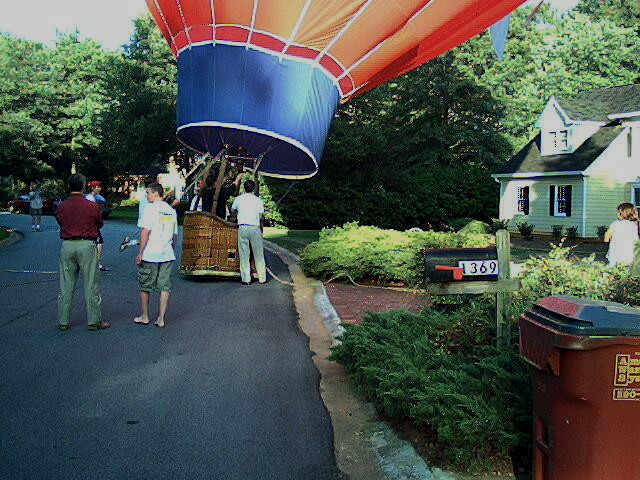
At this point, the balloon is physically
ready to launch. Final checkout and loading of the basket remain.
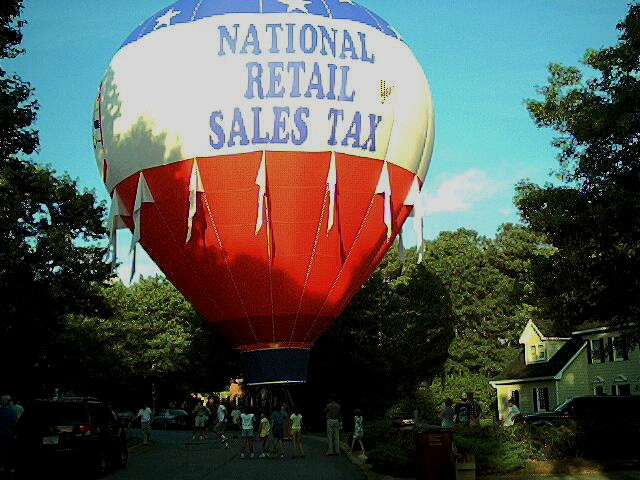
3. Pre-Launch Checklist
1. Envelope Inspection
Safety check....
2. Check Rigging - Crownline "Tie-off" -- Seal(pull)
Vent / Parachute
Verifying the parachute valve is fucntional.
3. Set Instruments -- "Hands and Weight On"
4. Fuel Tank Check - All Tanks..Close Tank #1, Open Tank
#4,
..Close Tank #2, Open Tank #3,
..Close Tank #3, Open (return) to Tank #2
Start Flight on Diagonal Tanks #2 and #4
Checking out the tanks. Use opposite corner
tanks to balance the load as the propane is used Otherwise the
basket will be uneven.
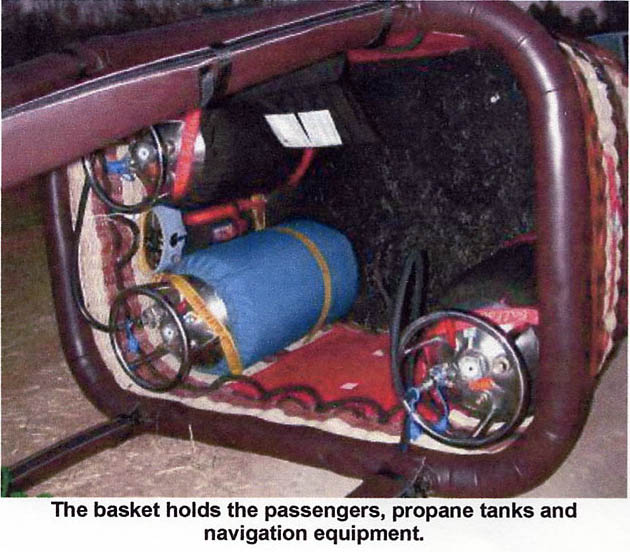
5. Radio/Communications check ...frequency coordination
...$0.25 coin? ...cell phone #'s.
Verification of the radios back/forth and on the correct,
agreed to frequencies (codes). Backup #'s and quarters in case
you have to come down and your crew can't locate you. (other
communication failure...)
6. On-board equipment check ...strikers, fire-extinguishers,
drop-line, velcro-tie for burner, wrench, screwdriver, gloves
and clock
Basic equipment to be able to restart burners, put out any
fire, rope and various tools, just in case...
7. Crew and Passenger Briefing ...Ask Crew: "Who has
the keys?"
Basically, who is going to be piloting. Everyone else is a
navigator.
8. "Hands On - Weight Off" - Equilibrium Check
Bump up a little from the ground (while still being held by
the lines) to check the stability of the basket with all aboard.
9. Release of tie-down anchor
10. Downwind Walking Launch
The crew will walk with the ballooon down wind, as it begins
to lift off. They will keep the speed to a walking speed (<
2miles per hour)
11. Burn for Obstacle Clearance
Run the burners fast enough/long enough to clear all the immediate
launch obstacles.
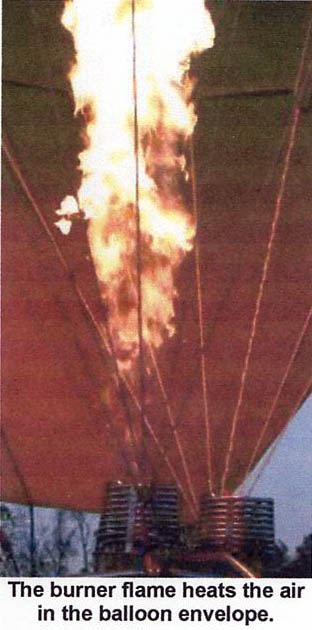
4. Inflight Checks
1. Fuel Management - short burns
2. 30-minute fuel gauge check ...burn to 15% then switch
tanks
3. Switch from tank #4 to tank #1
As Tank 4 is used up.
4. Obstacle Avoidance
5. Landing Site Evaluation
6. Switch to final full tank, #3, prior to approach ...Close
#2 - Open #3
5. Landing Approach Checklist
1. Alert Crew and Passengers ..."Help Look for Power
Lines"
2. Landing Abort / Missed Approach Plan
3. Parachute Vent (or valve) Line
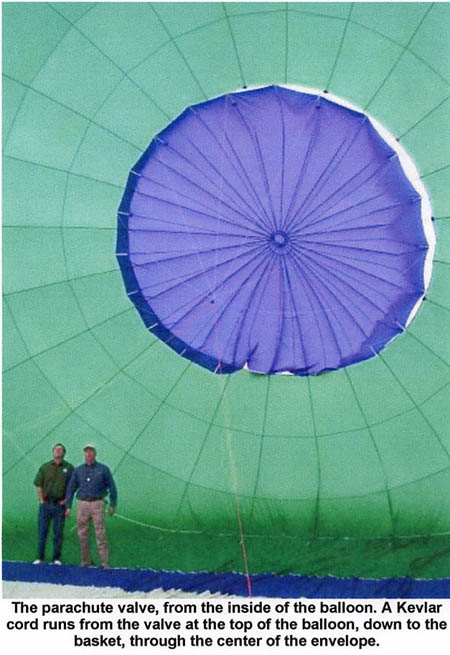
4. "Hands Inside and Low" - "Flex Your Knees"
- "Hold on Red Tie Straps Inside Basket"
Safety check, no limbs outside of the basket to avoid injury.
5. All Passengers stay inside basket until balloon is stable
and wait for Pilot's Instuctions
6. Post-Landing Procedures
1. Pilot and Burner Off ...Call for "No Smoking"
2. Cool Burner with Propane Blast
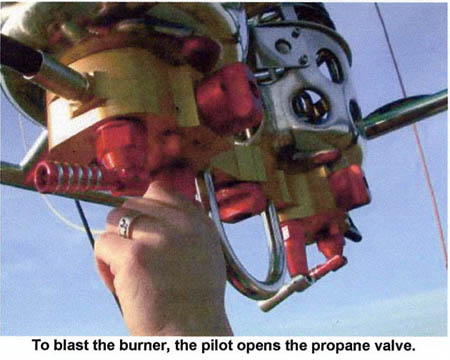
3. Fuel Valves Off
4. Bleed Fuel Lines
5. Crownline Down Wind
6. Release Parachute Vent ...Allow Ballon to chimney
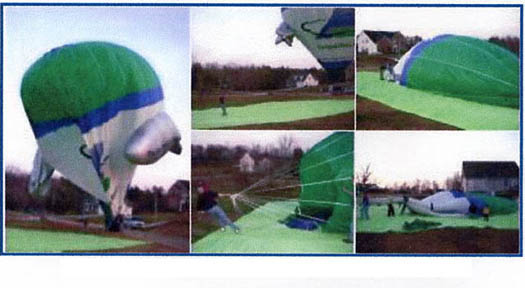
7. Dissassemble and Storage
8. Landowner Relations - GBA Raffle...
Make sure you have something for the landowner (if not known
beforehand) where the landing occurred.
(Return to Previous Page)
